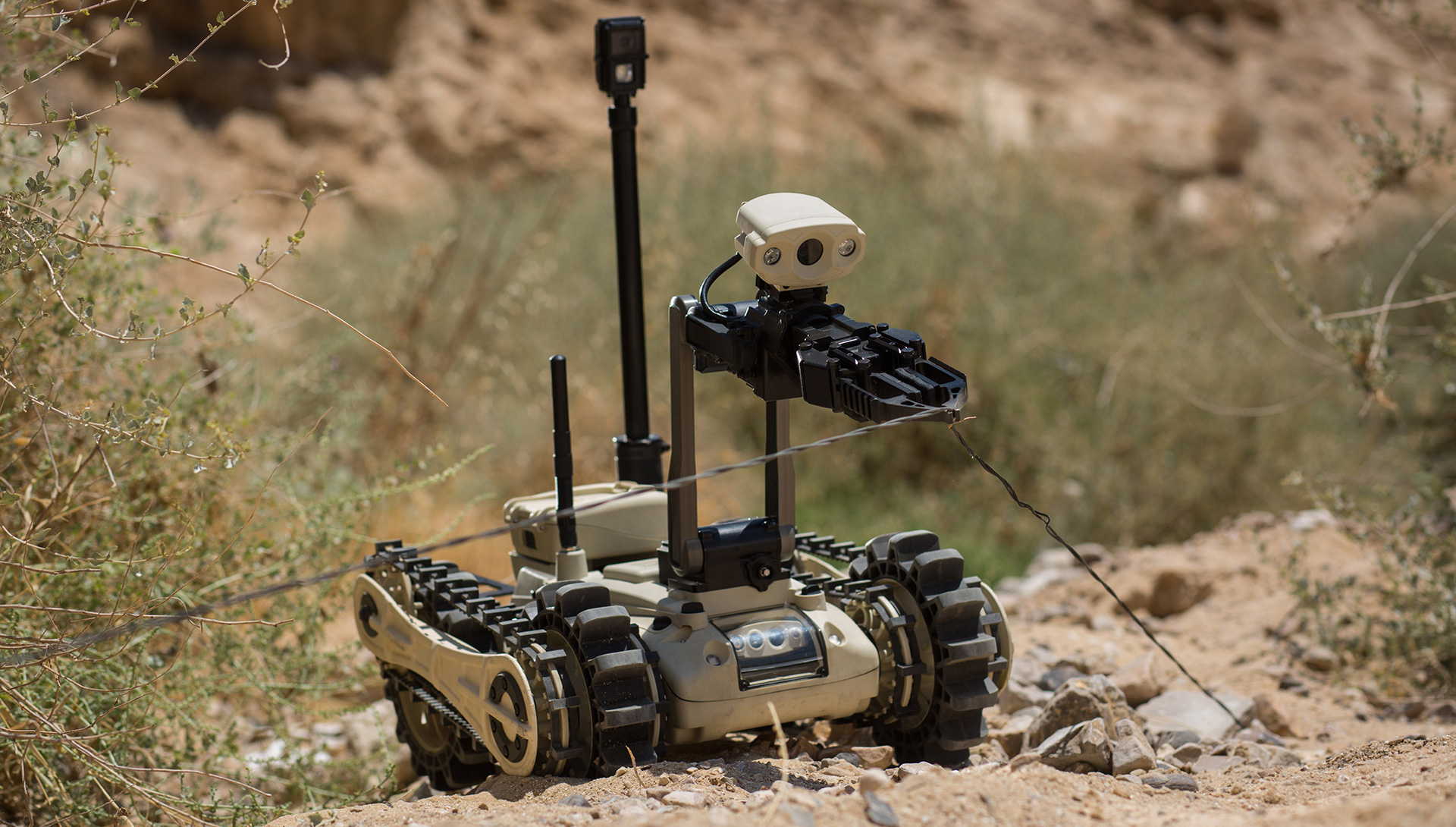
We continue the review of military robots. In the
first part, we reviewed samples of QinetiQ (Great Britain), Boston Dynamics (USA) and Izhevsk Radio Plant OJSC (Russia). This time, robots capable of working on and under water were added to the ground-based ones.
iRobot, USA
The company was founded by three scientists at the Massachusetts Institute of Technology in 1990. Produced military robots with funding DARPA. In addition, it is known for the production of household robots:
Roomba Robotic Vacuum Cleaner, Braava Robot Swab, and Mirra Pool Cleaner
Robot . In 2016, iRobot decided to focus on the peaceful application of robotics and sold the militarized product development business to
Arlington Capital Partners . But before that, iRobot managed to produce a lot of robots for military purposes.
PackBot - the first military robot company funded by DARPA (the contract was signed in 1998). In fact, it is a robotic platform on which you can install various tools depending on the task being performed. The basic version of PackBot Scout had five compartments for devices. PackBot Explorer is equipped with cameras (including infrared), a laser pointer, audio sensors. The most common configuration was the PackBot 510 - this robot could be equipped with devices for demining explosive devices, REDOWL systems for detecting snipers, and even sets for detecting radiation contamination. The modern version of the PackBot 510 with a manipulator weighs 10.89 kg, accelerates to 9.3 km / h and can work autonomously from 4 to 8 hours depending on the intensity of use. PackBot robots were widely used by the US military in Iraq and Afghanistan. Several PackBot were also involved in search and rescue operations after the terrorist attacks of September 11, 2001 in the United States.
 110 FirstLook
110 FirstLook is a multi-purpose, compact tracked robot developed in 2011. The main purpose is to assist in the detection of potential danger during a combat operation. Equipped with four infrared cameras and a means of communication. It can safely fall from a height of 4.5 m onto a hard surface. Moreover, if it turns over, it can return to its original position due to the swiveling flippers. Example of use: it is thrown manually into the window and transfers the image to the control panel. The weight of the robot is 2.4 kg, the length is 25.4 cm, the maximum speed is 5.5 km / h, it works up to 6 hours at a distance of up to 200 m from the operator. Depending on the task being performed, it can be additionally equipped with a manipulator for deactivating explosive devices, a thermal imager, as well as means of bacteriological, chemical and radiation reconnaissance. Operating temperatures range from -20 ° C to +55 ° C. In 2012, the Joint Improvised-Threat Defeat Organization (JIDO) acquired a hundred of such robots, and later the Pentagon ordered another 500 to work in Afghanistan.
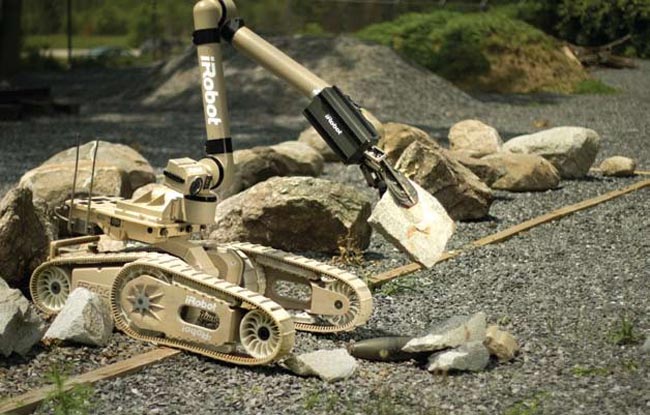
is a robotic platform designed primarily for moving potentially dangerous objects (for example, unexploded ordnance). If necessary, it can be used for clearing the way, extinguishing a fire or reconnaissance. Thanks to the robotic arm, it can also take wounded soldiers from the battlefield by grabbing their clothes. Equipped with video cameras and a number of sensors. The weight of the platform without a manipulator is 165.6 kg, with a manipulator - 226.8 kg. The manipulator can be extended to a distance of 192.2 cm, in the fully extended position it operates with a load of up to 31.6 kg, in the closed position with a load of up to 136.1 kg. The robot overcomes obstacles in height to 47 cm and can move under an inclination to 45º. It works from 4 to 10 hours and is controlled at a distance of 800 m from the operator.
Seaglider - autonomous uninhabited underwater vehicle, which in fact was developed by the University of Washington, but gained popularity after iRobot in 2008 acquired the right to manufacture the device. It studies the physical, biological, and chemical properties of water and can transmit the received data using a transmitter and a tail antenna. To do this, the device floats so that the tail part is above the water surface. The appearance of the robot resembles a rocket. The battery life (depending on the mission) is up to 10 months with a power reserve of 4,600 km. With a weight of 52 kg, the robot plunges to a depth of 1000 m and moves at a speed of 0.5 knots. In May 2010, Seaglider participated in research on the waters of the Gulf of Mexico after the incident with the explosion of the oil platform Deepwater Horizon.
Ranger is an unmanned underwater vehicle, also developed not by iRobot, but by a company called Nekton Research. The latter was acquired by iRobot, and the original development team joined the new company. The robot participates in expedition missions, missions to detect underwater mines, reconnaissance and patrol missions. Unlike the Seaglider, the Ranger is equipped with a propeller and is designed for short-term tasks. With a total length of 0.86 m, it weighs slightly less than 20 kg and moves at a speed of about 15 knots (27.78 km / h).
Transphibian - autonomous uninhabited underwater vehicle, designed to search for mines, reconnaissance operations and surveillance of the water area. It uses a hybrid navigation system, thanks to which it can perform tasks both in shallow water and in depth. Equipped with four fins. In motion, it looks like a little turtle that does not know how to swim.
Chembot - the project of a flexible miniature robot, the development of which was sponsored by DARPA - they needed a robot that could squeeze into a hole with a diameter of about 30 mm. As planned, the design should be free of solid materials, and the “skin” of the robot should consist of an elastic polymer that can expand and contract. The robot came into motion due to the changing pressure of air in different parts of its “body”. Separate prototypes of robots were created, but the creators did not figure out how to make it autonomous and get rid of a heap of wires responsible for pressure.
LANdroid - a miniature robot router. IRobot won a competition from DARPA for its development in 2008. A year later, LANdroid Ember was released, which was placed in a cargo pocket on military pants. The purpose of the robot is to quickly build a wireless network for receiving and sending information in battle sites. The robot was equipped with cameras and antennas. The design also provides rotary flippers.
Samsung Techwin (now Hanwha Techwin), South Korea
The company was founded in 1977 under the name Samsung Techwin, as a subsidiary of Samsung. In 1979, she began to make video cameras. A year later, she switched to jet engines for the South Korean Air Force (produced jointly with General Electric). Since then, the company has participated in the production of helicopters, video recorders, video surveillance systems, lenses. Together with other companies, she developed semiconductors, optical communication systems, was engaged in research activities in the aerospace industry and worked with nanotechnologies. In December 2014, Samsung announced the sale of Techwin to the South Korean conglomerate Hanwha Group. In June 2015, the takeover was completed and the company was renamed Hanwha Techwin.
 The Samsung SGR-A1
The Samsung SGR-A1 is a robotic turret designed to support South Korean military forces in the Korean Demilitarized Zone. Development began in 2003, and in 2006, the first prototypes appeared. Equipped with a laser range finder, an infrared thermographic camera, an infrared illuminator, a 5.56-mm Daewoo K3 machine gun and a 40-mm Milkor M32 multi-charge semi-automatic grenade launcher. It can track and lead targets both during the day (range up to 4 km) and at night (range 2 km). But for the use of lethal weapons needed operator. The weight of the structure is 117 kg, the height is 120 cm, the range is up to 3.2 km.
JSC "766 Management of Production and Technological Equipment", Russia
"766 UPTK" was established in 2001 and specializes in the development and production of military robotics. It has its own engineering and design center. Among other types of activities, research, design, experimental and testing works, as well as development and production of certain types of building materials and structures are indicated.
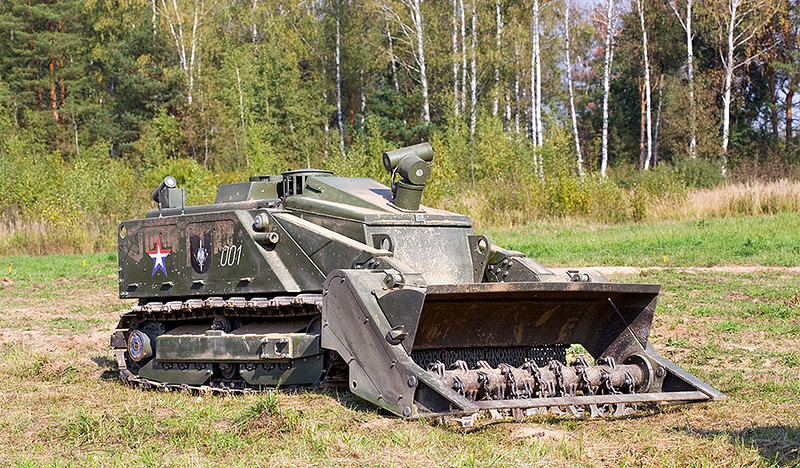 "Uran-6"
"Uran-6" - a robotic tracked complex for clearance of dangerous areas of the terrain. It can work in urbanized, mountainous and low-weight territory. In essence, this is nothing more than a remote-controlled mine sweep. Four cameras provide all-round visibility. Five interchangeable tools are provided for interacting with different types of soil. The robot works on a surface with a slope of up to 20º and overcomes obstacles up to 1 m high. It can lift weight up to 1 ton. The robot itself weighs 6 tons, it can work 5 hours without refueling (it uses diesel fuel). The complex is managed at a distance of up to 800 m. Uran-6 took part in the demining of Palmyra.
Uran-9 is a multifunctional combat robotic complex. The main purpose - fire support and intelligence. Thanks to the modular system can be equipped with various types of weapons. Standard set: Kalashnikov machine gun tank modernized (PKTM) 7.62 mm caliber, 2A72 automatic cannon 30 mm caliber, Attack guided weapon system and four RPM PDM-A Shmel-M flamethrowers. Equipped with a warning system for laser irradiation and a smoke screen system. Also equipped with thermal sensors, laser rangefinder, day and night cameras. In curb weight weighs 12 tons and can travel at speeds of up to 35 km / h. On one refueling diesel engine can work 6 hours in a row. Management of the complex is carried out at a distance of 4 km. Hit targets at a distance of 5 km during the day and up to 3.5 km at night.
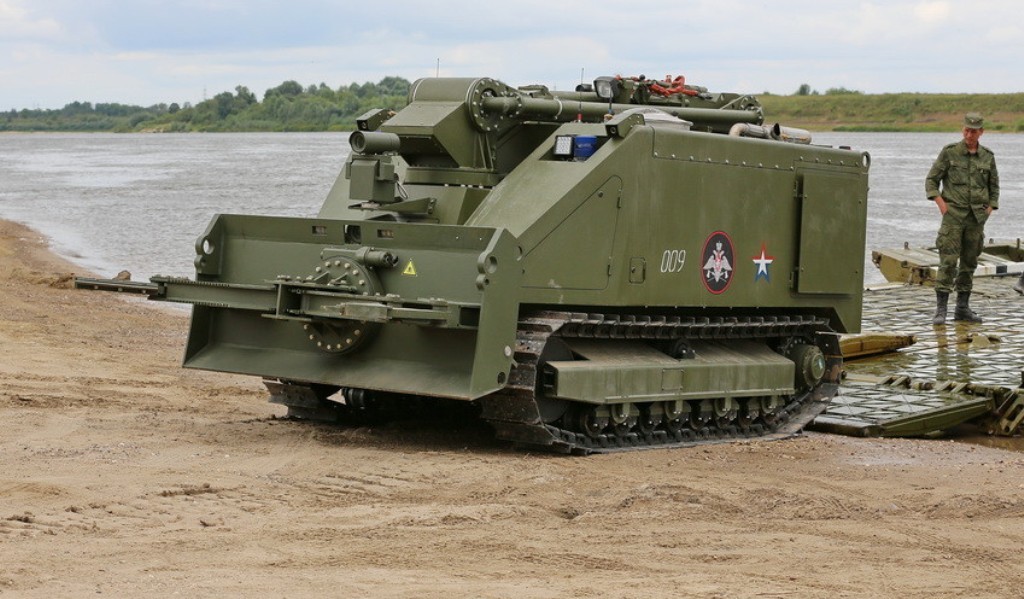 "Uranium-14"
"Uranium-14" - robotic fire extinguishing complex. It is intended for remote extinguishing of fires in dangerous or hard-to-reach places, for example, in a burning ammunition depot. It can be used for reconnaissance of fires, including hidden ones, thanks to thermal imaging video surveillance system. Works on surfaces with a slope of up to 30º. The curb weight is 14 tons, the maximum speed of movement is 10 km / h, the distance of the water jet is 50 m. It is controlled remotely at a distance of 1 km.
OAO NITI Progress, Russia
This research institute of technology was established in June 1959 to accelerate the development and production of a single-stage liquid ballistic missile R-17. For his contribution to the creation of new types of rocket technology, NITI Progress was awarded the Order of the Red Banner of Labor in 1982. In addition to orders from the defense industry, the institute develops equipment for processing gold-bearing ores, printing money, winding protective coatings, producing tire covers, repairing heating grids, wood processing and other fields of activity.
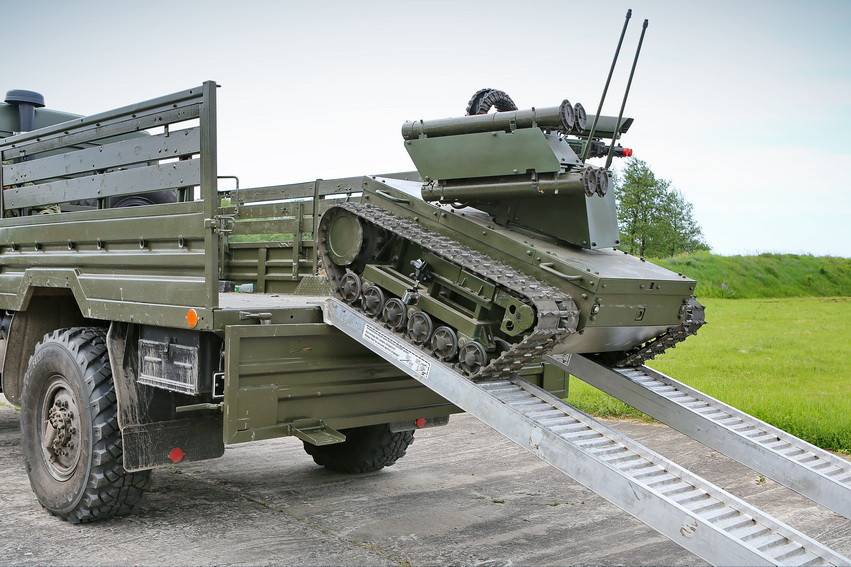 Platform-M
Platform-M is a multifunctional robotic tracked complex. Intended primarily for fire support units in combat and reconnaissance tasks. A minelayer or trawl can be “hung” on the robot - then it will be able to perform mining or demining tasks. The robot is equipped with a Kalashnikov machine gun tank modernized (PKTM) 7.62 mm caliber with 400 rounds of ammunition, four 30 mm caliber AGS-30 grenade launchers, as well as the Cornet anti-tank missile system. Works on surfaces with a slope of up to 25º. With a body weight of 800 kg, the robot moves at a speed of up to 12 km / h and
can carry a weight of up to 300 kg. Own power supply is enough for 10 hours of continuous movement. The construction of the robot also includes video cameras, a range finder, a thermal imager and the Fara radar.
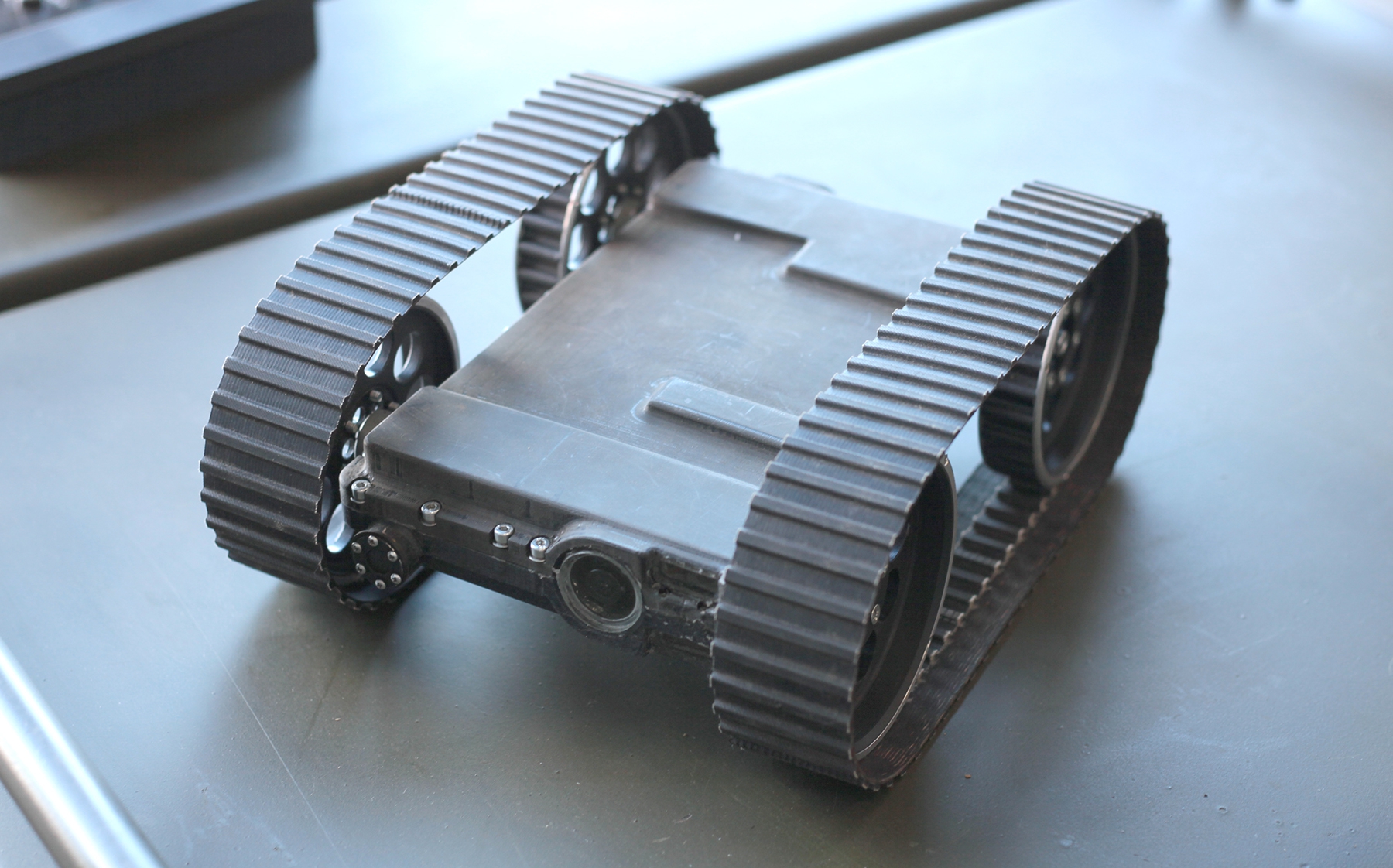 The SRR
The SRR is a compact robot of which little is known. Equipped with two video cameras and due to its small size can perform reconnaissance tasks. For example, it may be manually thrown into the window of a building and transmit to the operator an image of what is inside. Works on tracks.
Exponent, United States
The company was founded as Failure Analysis Associates in April 1967. Takes part in investigations of catastrophes and other incidents: from fires and plane crashes to oil spills and aerial bombardments. Also engaged in the study of the effects of damage. On instructions from NASA in 1986, the company was engaged in research into the Challenger shuttle disaster. Known for research and development in more than 20 scientific fields. Renamed Exponent in 1998.
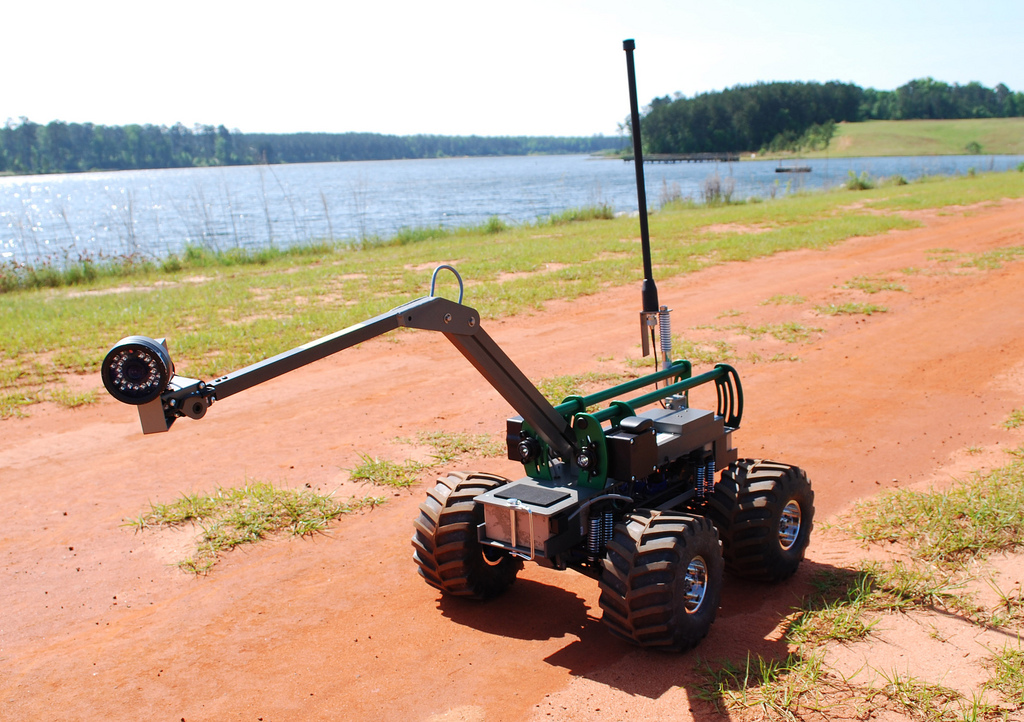 MARCbot
MARCbot is a wheelbase robotic platform designed to detect explosive devices. Created in 2004 and developed as an inexpensive version of the robot for use in Iraq. Equipped with a video camera on a retractable rod to check various objects (such as cars) for the presence of explosive devices. It is one of the smallest and most frequently used robots in Iraq. According to the essay of political scientist P.V. Singer "Robots at war: the new battlefield", some US Army soldiers in Iraq attached a C18more M18A1 anti-personnel fragmentation guided mine to MARCbot to send the robot ahead if they suspected an ambush. Construction weight - 15 kg, length - 61 cm, height - 34 cm. Works up to 6 hours in a row on one battery charge. Operated at a distance of 300 m from the operator.
SKTB applied robotics MSTU. N.E. Baumana, Russia
Special Design and Technology Bureau originates in 1972 - by order of the rector of the then Moscow Higher Technical School. N.E. Bauman was established student laboratory transport systems at the design and mechanical faculty. At its base, mock-ups of planetary rods and penetrometers were developed for installation on the lunar rover and
rover . In 1986, it became known as the Special Robotics Design Bureau of the Moscow Higher Technical School. N.E. Bauman, in 1999 - SKTB applied robotics MSTU. N.E. Bauman. Now it has become a LLC SKTB applied robotics. For more than 30 years, she has specialized in the development of mobile robotic systems and additional equipment. Develops including medical manipulators.
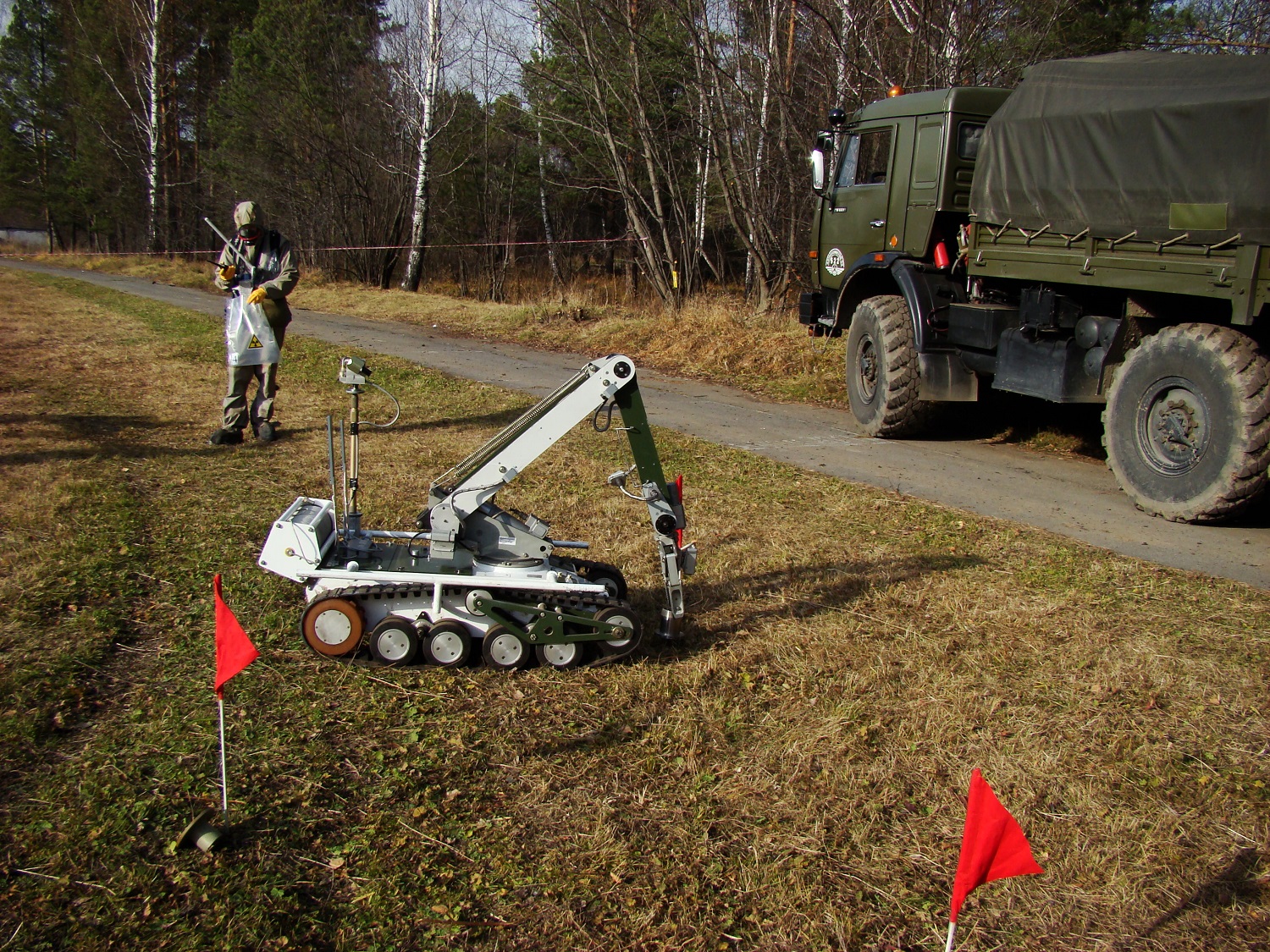 The MRK-27
The MRK-27 is a mobile robotic complex developed in 1994. Used to perform a wide range of tasks. For each created a separate modification. MRK-27-VT and MRK-27-VU are equipped with manipulators and are designed for blasting and movement of explosive devices. MRK-27-MA -
for work in conditions of high radiation . MRK-27-X - for work in conditions of chemical contamination; it can analyze the air and put chemically dangerous objects in a special container. MRK-27-GP - for inspections of the area using a gas analyzer. A variant of the MRK-27-BT ("combat point") is intended for fire support units. It is equipped with a 7.62 mm “Pecheneg” machine gun, two RShG-2 rocket-propelled grenades, two RPO-A “Bumblebee” rocket-projectile flamethrowers and six KRAH mortar type grenades. In addition, each of the modifications of the robot can conduct visual reconnaissance. The base platform operates on a single-compartment chassis with variable track geometry. The manipulator has five degrees of freedom. It can be additionally equipped with a hydraulic destroyer, sliding device, power tools and protective armor sets. The weight of the platform MRK-27 is not more than 210 kg, length - 112 cm, height - 65 cm. It works on surfaces with a slope of up to 20º. Equipped with batteries, which are enough for 4 hours of continuous work. Performs tasks at temperatures from -30 ° C to +40 ° C.
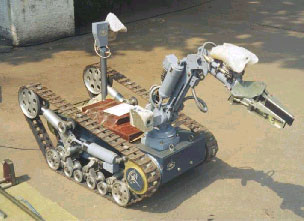
is a mobile robotic complex on a tracked chassis. Equipped with a camera, lighting system and manipulator. We intend to detect and recognize explosive devices. With its own weight of 186 kg, the robot can work on surfaces with a slope of up to 40º. A remarkable story is connected with the "Grasshopper". In June 1997, an uncontrollable nuclear reaction began at the Russian Federal Nuclear Center "Arzamas-16" due to a mistake. People were evacuated from the facility. To prevent the second Chernobyl, a German robot
MF-4 from Telerob was sent — he had to pull out a container with plutonium-239. But he could not stand the radiation and failed. He was replaced from Moscow urgently flew MRK-25 "Grasshopper", which pulled out not only a container with plutonium, but also a non-working German robot.
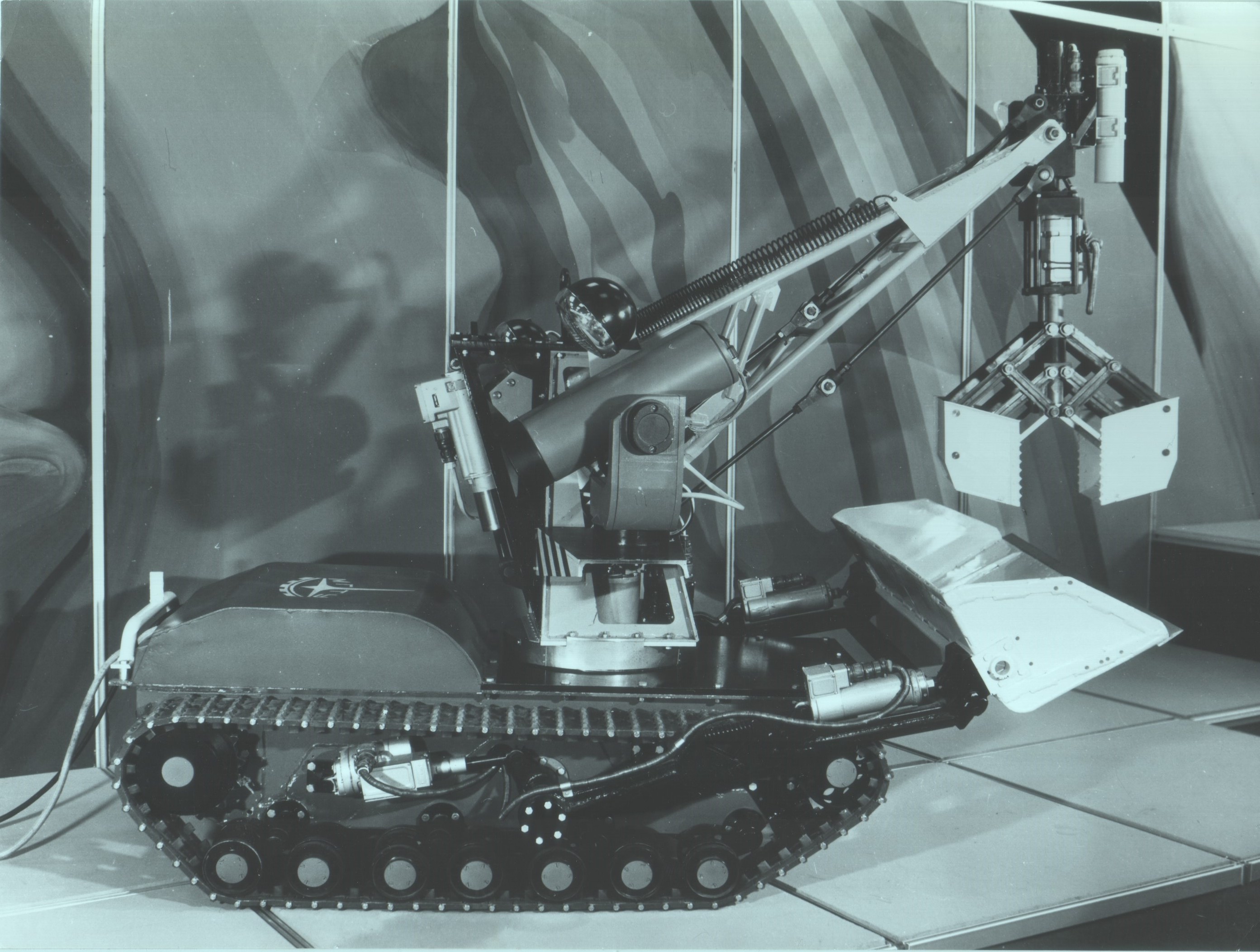 MOBOT H-HV
MOBOT H-HV is a mobile robot designed to eliminate accidents at the Chernobyl nuclear power plant. "Mobot" - means "mobile robot", "H" - "Chernobyl", and "XB" - "chemical troops". It was on the instructions of the head of the chemical troops of the USSR Ministry of Defense in August 1986 that this robot was developed. He carried out dosimetric reconnaissance, removed radioactive debris, dismantled pipes, erected roof formwork for the “M” zone, placed beacons and carried out other works. Equipped with a tracked chassis with polyurethane tracks, cable layer, manipulator, front loader and two TV cameras. Later, it was finalized and equipped with a jackhammer, docking device, a new manipulator with a two-finger grip and an acoustic communication system. The total weight of the robot reached 430 kg.
Roboteam, Israel
The company was founded in 2009, is based in Tel Aviv, and is headquartered in Geytensberg (a city in the United States). Develops and manufactures multi-purpose robotic platforms for military, law enforcement, special forces and peacekeeping missions.
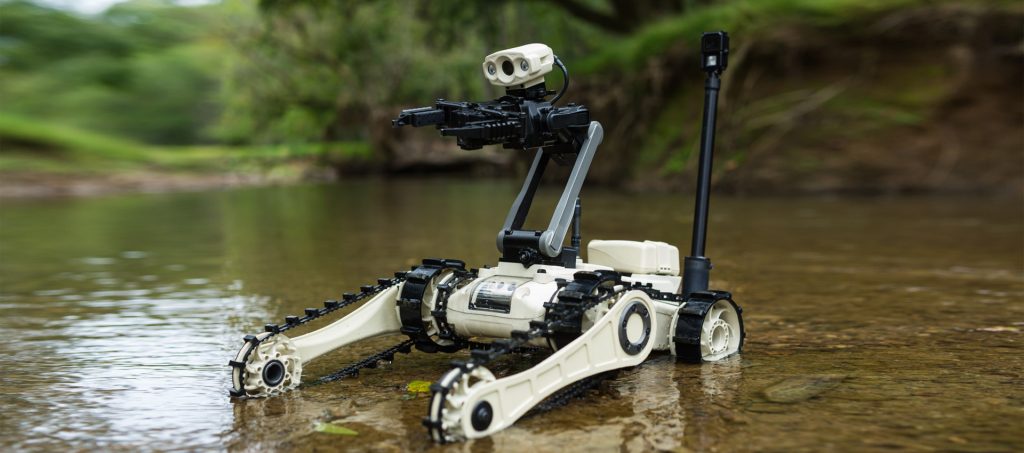 MTGR
MTGR is a small-sized robot designed for mine clearance of explosive items, reconnaissance, detection of chemical, bacteriological or radiation contamination. It is equipped with 8 cameras, providing a 360-degree view, with two cameras located directly on the manipulator. Can move with a slope of up to 45 °. The maximum speed is 3.5 km / h, the operating time on one battery charge is 3 hours, the dead weight is 9.4 kg. Carries goods weighing up to 10 kg. The manipulator is able to lift loads weighing up to 5 kg in a fully straightened state (in this case, its length will be 49 cm). Works in temperatures from -20 ° C to +60 ° C. Operated by the operator at distances up to 500 m.
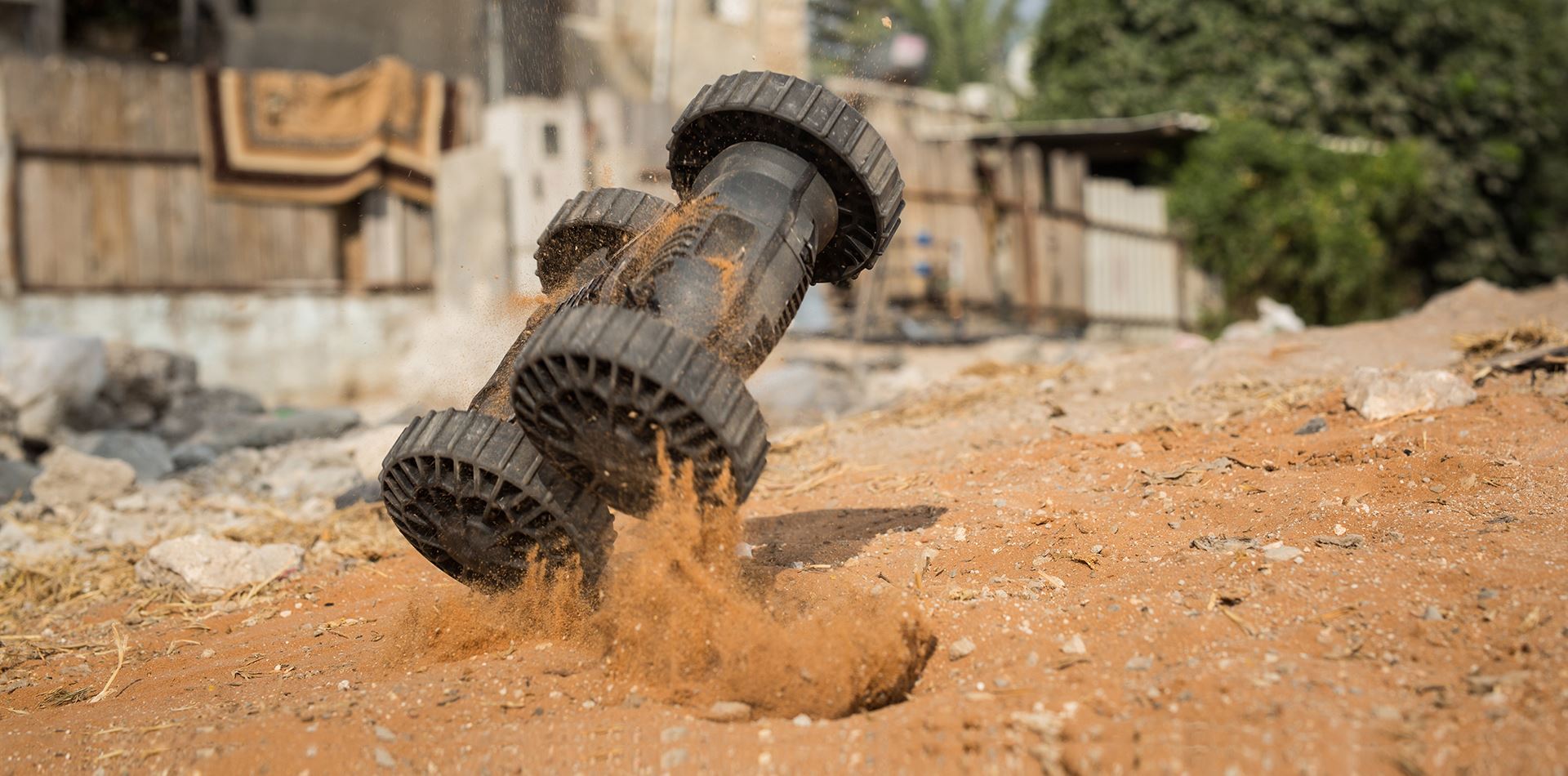 IRIS
IRIS is a lightweight “throw-away” type robot on a wheeled platform. It can work in sand, mud, water and on stones (the developer is silent about snow). Equipped with two PTZ cameras and is designed for reconnaissance missions. The robot weighs 1.85 kg and can carry 1 kg of cargo on it. Its length is 23 cm, and its height is 11 cm. It develops a speed of up to 5 km / h and works up to 2 hours on a single battery charge. It is controlled remotely - up to 200 m from the operator. It operates in the temperature range from -20 ° C to +60 ° C.
 PROBOT
PROBOT is an
off -
road robotic platform designed for the transport of goods. Can participate in search and rescue operations or evacuate the wounded from the battlefield. Cameras (including night vision) are installed on the robot, providing a 360-degree view. In some cases, equipped with sensors for bacteriological, chemical and radiation reconnaissance. The weight of the platform itself is 410 kg, but it can carry up to 700 kg of payload. It reaches a speed of up to 9.6 km / h and can move autonomously for up to 8 hours in a row. Its dimensions are impressive: 150x120x60 cm.
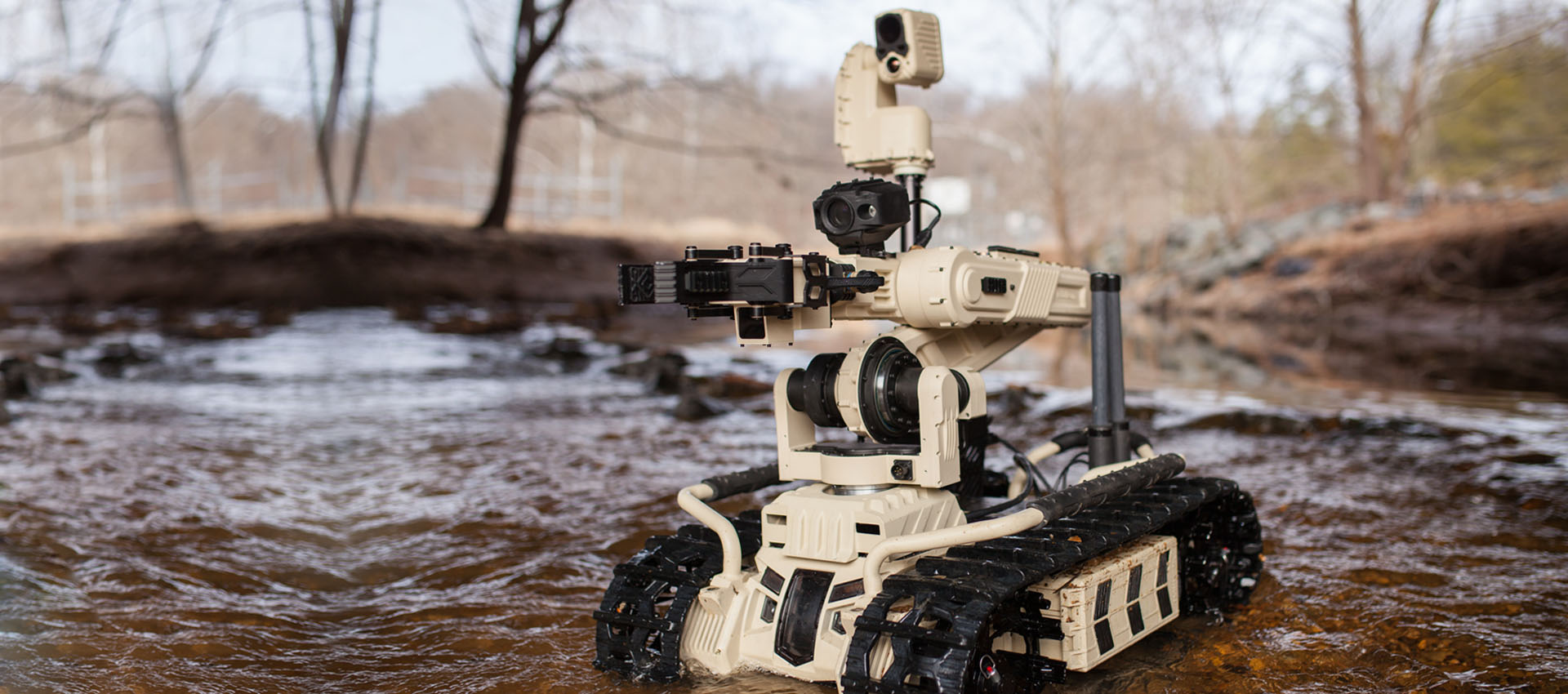 TIGR
TIGR is an all-weather robot designed for engineering work. Equipped with a manipulator with five degrees of freedom, which is able to lift 19 kg in the folded state and 7 kg in the stretched one. It is completed with modules of day and night vision (five color cameras and one thermal), which allows using it as a scout. The manufacturer claims that the robot operates at temperatures from -32 ° C to +49 ° C. The platform weight is 74 kg, length - 91.2 cm, height - 35.3 cm. It is equipped with a human recognition system that works correctly during the daytime at a distance of up to 600 m, and at night at a distance of up to 300 m.
General Robotics, Israel
Private company founded in 2009. Engaged in research, development and production of robotic platforms for the defense markets of different countries.
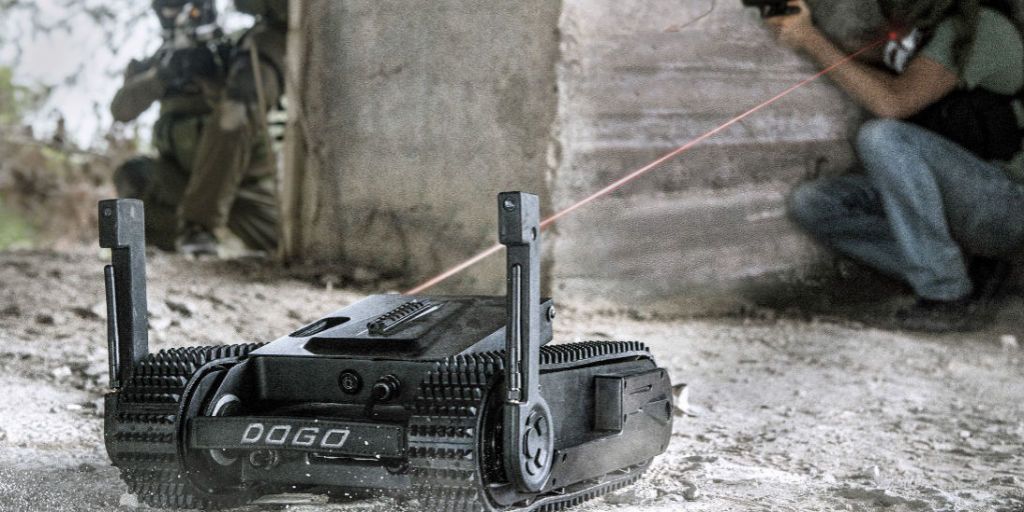 DOGO
DOGO is a miniature reconnaissance robot equipped with lethal weapons. It is used not only in reconnaissance, but also in assault operations, when it is necessary to identify and eliminate the threat. For this purpose, it is completed with a Glock26 9 mm self-loading pistol and a laser pointer. The weight of the robot is 10 kg. Responsible for the review of 8 cameras with infrared illumination. On November 13, the company presented a “less lethal” module for DOGO. In it, instead of a pistol, a canister with pepper gas is installed to neutralize the target.
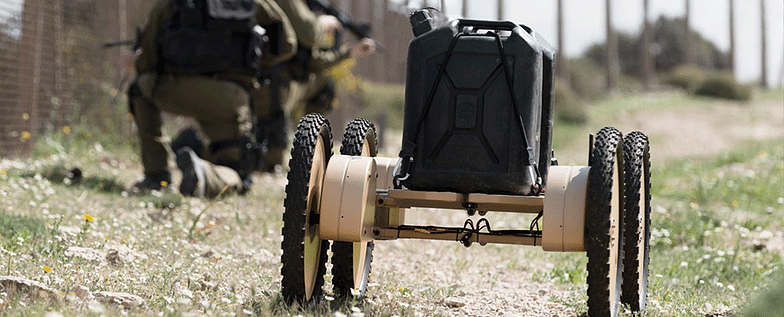 DONKEY
DONKEY - the folding multifunctional robot for fast deployment on the ground. Designed for exploration, paving, transportation of cargo. Due to the modular structure, it can be equipped with a manipulator, which makes it suitable for sapper work. It weighs 40 kg, can carry loads of up to 70 kg. It has a silent stroke thanks to four electric motors - one for each wheel. Maximum speed - 16 km / h, power reserve - 40 km. It can work on surfaces with a slope of up to 30º.
Guardbot, United States
This is an American engineering company, located in the city of Stamford near New York. He specializes in the development of amphibious spherical robotic systems. However, until now she has created only one product - he repeats the name of the company. According to the creators, the Guardbot project was originally conceived
for a mission on Mars .
Guardbot is a robotic spherical system, the main purpose of which is to search for explosive devices and monitor territory or water area. The propeller is based on a patented mechanism with a pendulum. The robot moves by changing the center of gravity. At the same time he is able to work on the ground, sand, water and snow. The speed of movement on land is up to 20 km / h, on water - 6.5 km / h. The kit includes day and night cameras, a sensor for determining the WMD, a laser scanner. The construction weighs 26 kg, the diameter in the thin section is 60 cm, in the wide section 91.5 cm. It is equipped with two electric motors and can work autonomously for up to 25 hours. Despite the spherical design, overcomes the slopes of up to 30º. Works at temperatures from -30 ° C to +40 ° C.
Ahead - the third part.